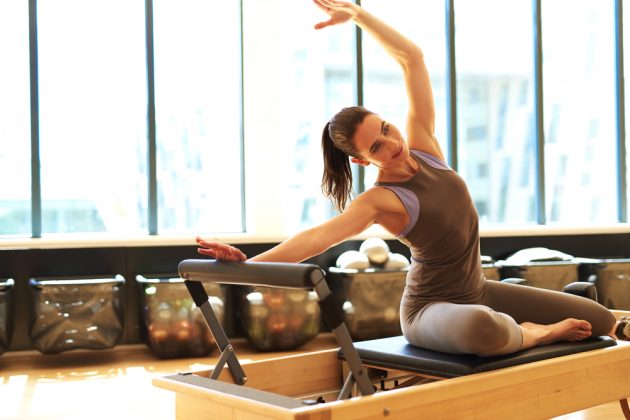
I have practiced and taught pilates for over ten years and I can say without a doubt that pilates has improved my performance in every sport and fitness activity I have engaged in—running, skiing, soccer, hiking, squash, golf, tennis and more. I am confident pilates helps in a myriad of ways in all other sports as well. Here’s how:
Increased core strength. Most athletes understand the importance of a strong core, but some do not really understand what the word “core” refers to precisely. Core strength is not synonymous with abdominal strength. Your core encompasses your entire torso, including your hips, abdominals, back, shoulders and neck. When all of the muscles in the torso are strong and balanced, your core acts as a stabilizer and a center for you to transfer forces through when you are running or doing other activities. Pilates enables you to not only better produce force during activities such as running, but it helps you better control and maximize the forces you produce while you are active.
Corrects postural imbalances, which helps reduce the risk of injury. Every athlete’s first priority should be to achieve core stability through balanced musculature. In other words, stability first and movement second. Core stability protects the spine and surrounding musculature from injury during dynamic movement. Since pilates encourages proper movement patterns and teaches correct posture, you are less likely to re-injure the same area or hurt something else through compensation. Additionally, pilates helps you identify your weaknesses that inhibit your gait. You learn muscular cues to help you fire and strengthen muscles that help you maintain a better running posture.
RELATED: This Is The Easiest Way To Improve Your Posture
Improved endurance and speed. Most runners understand that a strong, balanced body helps you maintain proper form as you fatigue. Pilates helps you loosen your hips, legs and back, all helping you keep a fluid, long stride. Also, it is important to keep your psoas (abdominal muscles that connect the spinal column to the femurs and assist in flexing and rotating the leg and flexing the trunk on the pelvis) in optimal condition by keeping them flexible as well as powerful.
Quicker and more comprehensive recovery. Pilates will decrease your recovery time after injury or a strenuous workout by increasing joint mobility, improving flexibility and body awareness. With a regular pilates routine, your muscles are in better condition, so you feel less fatigued, sore and tight after a long run.
Breath control. Breathing patterns are essential to performing pilates movements correctly, and such practice easily translates into running. Pilates teaches you to fill the lower lobes of your lungs more fully, to engage your diaphragm more consciously and to use breath with increased awareness to assist your movement patterns.
RELATED: What Is The Best Way To Breathe While Running?
Improved balance. One of the fundamentals of pilates is to emphasize balance along with mobility and breath control. Balance decreases with age, and those who regularly practice pilates see dramatic gains in balance and have an easier time maintaining it as they age. If you’ve ever tripped or stumbled on a rocky trail while running, you understand how crucial it is for your core muscles to come to the rescue.
August 11, 2017
August 11, 2017
August 11, 2017